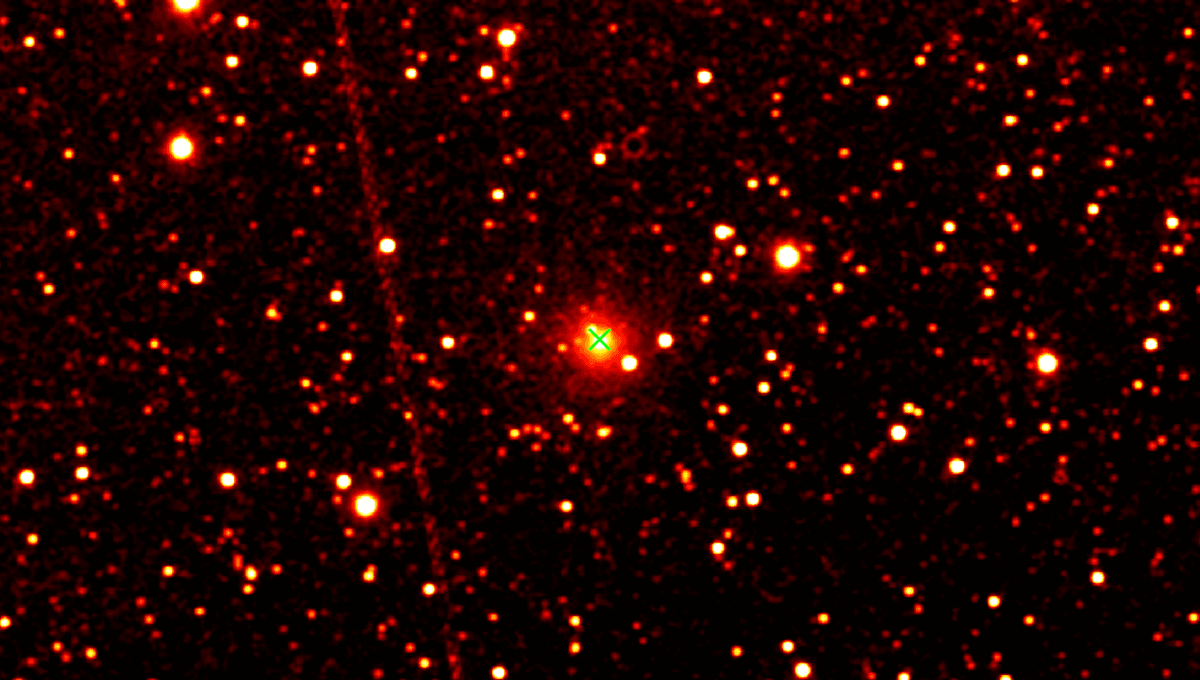
A team of astronomers have presented the first polarimetric observations of interstellar comet 3I/ATLAS, finding that it has extreme negative polarization.
On July 1, 2025, astronomers spotted an object moving through the Solar System at nearly twice the velocity of previous interstellar visitors ‘Oumuamua and Comet Borisov. The object was confirmed to be an interstellar comet with its own dusty coma, and suspected to be far larger than the previous two, with a estimated nucleus (the rocky part of the comet, excluding its coma) of around 5.6 kilometers (3.5 miles), and a possible “anomalous” mass of over 33 billion tons.
The astronomical community continued to track the object, known to be a comet due to outgassing as it has approached closer to the Sun, as it made its way through the Solar System. Unfortunately, and after potentially being hit by a coronal mass ejection, it has now vanished from our view and won’t be back in sight until later this year.
Part of these observations have been imaging and spectroscopy of the object, revealing that it has a green tinge and some interesting chemistry going on, and its distinctive coma. But polarimetry, or measuring the rotation of plane-polarized light, can tell us a lot about about near and distant objects too, allowing astronomers to gain data on, for example, the size, shape, and orientation of dust particles surrounding a comet.
“Light is a wave consisting of a coupled oscillating electric and magnetic fields which are orthogonal to each other in a plane that is perpendicular to the direction of propagation of the wave (in vacuum),” Harvard astronomer Avi Loeb, who was not involved in the new research, explains in a blog post.
“The polarization of the wave corresponds to different modes of field oscillations. For linear polarization, the electric and magnetic fields oscillate along a single direction, whereas for circular polarization – the fields rotate at a constant rate in their plane as the wave travels, either in the right-hand or in the left-hand direction.”
“The level of polarization displayed by an object which scatters sunlight like 3I/ATLAS, reflects asymmetries in its global shape or its corpuscular composition. The polarization depends on the phase angle at which the 3I/ATLAS is observed, namely the angle between the Sun-3I/ATLAS axis and the 3I/ATLAS-observer axis.”
Measuring the degree of polarization can tell us a lot about 3I/ATLAS, and other, more local, comets. Astronomers measure the degree of polarization, as well as whether it is negative or positive.
“The degree of linear polarization Pr of sunlight scattered by cometary dust particles is measured as the difference between the fluxes perpendicular and parallel to the scattering plane (Sun-comet-observer plane), normalized by their sum, and is highly sensitive to the solar phase angle α (Sun-comet-observer angle),” the team explains in their paper, currently posted as an unreviewed preprint.
“Because of this definition, polarization is positive when the polarization direction is oriented perpendicular to the scattering plane, and negative when parallel.”
Comets we have observed so far can vary in their polarization based on their distance from the Sun, and the distance of the comet from our telescopes, but there are still trends within this. Generally comets fit into one of two categories (high polarization comets and low polarization comets) though there are a few oddballs out there, like Hale-Bopp, which are outliers for their unusually high polarization.
“3I is characterized by an extremely deep and narrow negative polarization branch, with parameters Pmin = −2.77 ± 0.11%, αmin = 6.41±1.27◦, α0 = 17.05±0.12◦, and h = 0.40±0.02% deg−1,” the team explains in their paper.
“This polarimetric behaviour is significantly different from all known comets (either interstellar or bound to our Solar System), not fitting into either the high or low-polarization comet categories, nor that of the unique category occupied by just Hale-Bopp and 2I.”
The team suggests that the comet has more in common with trans-Neptunian objects (TNOs), minor planets and smaller objects that orbit the Sun beyond Neptune, and Centaurs.
“While 3I’s inversion angle resembles that of rare F-type asteroids and cometary nuclei, the depth of its negative polarization branch is almost twice as large. Extrapolation to very small phase angles indicate a steep polarization slope between phase angles 0–2°, reminiscent of certain small TNOs and Centaurs,” the team writes. “While this finding is tentative due to a lack of data at small phase angles, it is consistent with the red spectral slope and evidence of water-ice detections in various independent studies.”
Further observations of the object are needed, but, of course, it is currently out of view.
“Imaging confirms a diffuse coma present from our earliest observations, though no strong polarimetric features are spatial resolved,” the team adds in a statement. “These findings may demonstrate that 3I represents a distinct type of comet, expanding the diversity of known interstellar bodies.”
The paper has been submitted to The Astrophysical Journal Letters but is currently unreviewed. It has been posted to preprint server arXiv.
Source Link: Interstellar Comet 3I/ATLAS Shows "Extreme Negative Polarization". What Does That Mean?